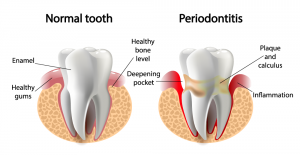What is Periodontal Disease and How Can You Treat It?
 I’m sure you have heard the term periodontal disease before. You will be surprised to know that gum disease is one of the most common oral health issues that very easily go unnoticed until it is too late. The gum diseases are not painful, which is why they are so easy to ignore. Periodontal diseases vary. It could be simple gum inflammation or a serious oral disease that may damage soft tissues and bone that strengthen your teeth. It could become worse, in which case you may end up losing a tooth or two. This is why it is so utterly important to floss and brush every day and schedule monthly dental appointments.
I’m sure you have heard the term periodontal disease before. You will be surprised to know that gum disease is one of the most common oral health issues that very easily go unnoticed until it is too late. The gum diseases are not painful, which is why they are so easy to ignore. Periodontal diseases vary. It could be simple gum inflammation or a serious oral disease that may damage soft tissues and bone that strengthen your teeth. It could become worse, in which case you may end up losing a tooth or two. This is why it is so utterly important to floss and brush every day and schedule monthly dental appointments.
Periodontal Disease Treatment
In periodontal disease treatment, the main goal is to restrict the infection whereas the types and number of treatment may vary. It is determined by examining the intensity of the gum disease. It is also based on how a patient is taking care of his teeth at home. The outcome of treatment could become satisfactory if patient works on certain habits, for example, not eating too much processed or sugary foods, etc.
 1. Deep Cleaning – the dental hygienist will use a deep cleaning process called scaling and root planning to remove the plaque. The scaling involves tartar removal from above and below the gumline. Through root planning, the patient can get rid of rough spots that occur on the tooth’s root. It also removes germs and bacteria that contribute to the periodontal disease.
1. Deep Cleaning – the dental hygienist will use a deep cleaning process called scaling and root planning to remove the plaque. The scaling involves tartar removal from above and below the gumline. Through root planning, the patient can get rid of rough spots that occur on the tooth’s root. It also removes germs and bacteria that contribute to the periodontal disease.
2. Medications – Your dentist may use medication with the procedures. These medications are not an alternative to surgeries. The periodontist may recommend surgery after examining the severity of your gum disease. It can be determined by long-term studies whether medications can work as surgery does and are they effective for longer period of time or not.
Surgical Treatments
Flap Surgery
During this surgery, the tartar is removed and the gums are placed back. It is also done to balance out uneven surfaces of the destroyed bone. The flap surgery leaves no space for germs that cause the disease. Then, the gums are put into their place to make tissue sit around tooth perfectly. The space between gum and tooth remain limited after the process. So, there are minimum chances left for bacteria to grow and for serious dental problems to occur.

Bone and tissue grafts
With bone grafts, the bone which was damaged by the gum disease is replaced by person’s own bone, synthetic bone, or even by a donated bone. These grafts are surgically implanted for the re-growth of the damaged bone, restoring the strength of the teeth. This new technology is known as tissue engineering – it is worth mentioning here that the procedure encourages your body to re-grow dental tissue and bone faster. Moreover, in soft tissue grafts, all those areas where there is a gum recession will be re-filled.
Examining oral health is essential to avoid any serious dental problem. So, do not wait, contact us and book an appointment immediately to learn more about your dental health with the reputed orthodontists in New York.